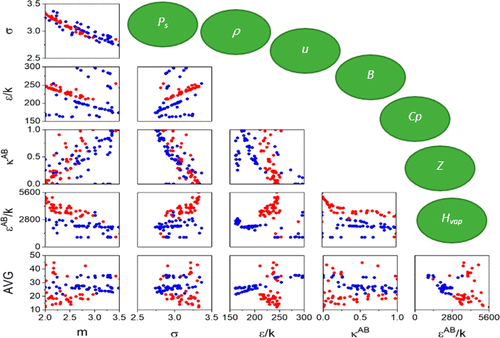当前位置:
X-MOL 学术
›
Ind. Eng. Chem. Res.
›
论文详情
Our official English website, www.x-mol.net, welcomes your feedback! (Note: you will need to create a separate account there.)
Extensive Study of the Capabilities and Limitations of the CPA and sPC-SAFT Equations of State in Modeling a Wide Range of Acetic Acid Properties
Industrial & Engineering Chemistry Research ( IF 4.2 ) Pub Date : 2018-04-16 , DOI: 10.1021/acs.iecr.8b00148 Rafael T. C. S. Ribeiro 1, 2 , André L. Alberton 1 , Márcio L. L. Paredes 1 , Georgios M. Kontogeorgis 2 , Xiaodong Liang 2
Industrial & Engineering Chemistry Research ( IF 4.2 ) Pub Date : 2018-04-16 , DOI: 10.1021/acs.iecr.8b00148 Rafael T. C. S. Ribeiro 1, 2 , André L. Alberton 1 , Márcio L. L. Paredes 1 , Georgios M. Kontogeorgis 2 , Xiaodong Liang 2
Affiliation

|
The accurate description of many thermodynamic properties of acetic acid and its mixtures can be a challenge to model with standard thermodynamic models such as local-composition activity coefficient models and cubic equations of state. A possible solution is offered by association equations of state, e.g., those belonging to the statistical associating fluid theory (SAFT) family. While several researchers have studied the use of SAFT variants to model acetic acid properties (pure compound and mixtures), with few exceptions, those studies focused exclusively on phase equilibria including vapor pressure and density. Other important properties, such as the speed of sound, second virial coefficient, compressibility factor, enthalpy of vaporization, and isobaric heat capacity have not been considered yet. Few studies investigate which is the appropriate association scheme to be used for acetic acid. In this work, we compare the capabilities of two association models, cubic plus association (CPA) and simplified perturbed-chain SAFT (sPC-SAFT), to predict a wide range of properties of acetic acid (mixtures) including derivative properties. We evaluate the influence of including one or more of those properties in the parameter estimation procedure for sPC-SAFT, we compare the results obtained with various choices of the association schemes (one or two sites), and finally we evaluate the performance of CPA and sPC-SAFT on correlating the phase equilibria of the binary mixtures of acetic acid with water, hexane, or ethanol. It is concluded that both equations of state perform overall similarly, with the one-site scheme performing better overall, especially for some properties. The results of the evaluation also show that some properties are intercorrelated in the parameter estimation process, making it essentially impossible to obtain sets that can accurately describe all the properties of acetic acid.
中文翻译:

广泛研究乙酸的CPA和sPC-SAFT状态方程在各种乙酸特性建模中的能力和局限性
乙酸及其混合物的许多热力学性质的准确描述对于用标准热力学模型(例如局部组成活度系数模型和状态立方方程)进行建模可能是一个挑战。状态关联方程提供了一种可能的解决方案,例如那些属于统计关联流体理论(SAFT)族的方程。尽管有几位研究人员研究了使用SAFT变体对乙酸特性(纯化合物和混合物)进行建模的方法,但几乎没有例外,这些研究仅专注于包括蒸汽压和密度在内的相平衡。尚未考虑其他重要属性,例如声速,第二维里系数,可压缩系数,汽化焓和等压热容。很少有研究研究哪种乙酸适用于合适的缔合方案。在这项工作中,我们比较了立方加缔合(CPA)和简化的扰动链SAFT(sPC-SAFT)这两种关联模型的功能,以预测乙酸(混合物)的各种特性,包括衍生特性。我们评估了在sPC-SAFT的参数估计程序中包括一个或多个这些属性的影响,我们比较了各种选择的关联方案(一个或两个站点)获得的结果,最后评估了CPA和sPC-SAFT可以关联乙酸与水,己烷或乙醇的二元混合物的相平衡。可以得出结论,两个状态方程的整体效果相似,而一站式方案的整体效果更好,特别是对于某些属性。评估结果还表明,某些属性在参数估计过程中是相互关联的,因此基本上不可能获得可以准确描述乙酸所有属性的数据集。
更新日期:2018-04-17
中文翻译:

广泛研究乙酸的CPA和sPC-SAFT状态方程在各种乙酸特性建模中的能力和局限性
乙酸及其混合物的许多热力学性质的准确描述对于用标准热力学模型(例如局部组成活度系数模型和状态立方方程)进行建模可能是一个挑战。状态关联方程提供了一种可能的解决方案,例如那些属于统计关联流体理论(SAFT)族的方程。尽管有几位研究人员研究了使用SAFT变体对乙酸特性(纯化合物和混合物)进行建模的方法,但几乎没有例外,这些研究仅专注于包括蒸汽压和密度在内的相平衡。尚未考虑其他重要属性,例如声速,第二维里系数,可压缩系数,汽化焓和等压热容。很少有研究研究哪种乙酸适用于合适的缔合方案。在这项工作中,我们比较了立方加缔合(CPA)和简化的扰动链SAFT(sPC-SAFT)这两种关联模型的功能,以预测乙酸(混合物)的各种特性,包括衍生特性。我们评估了在sPC-SAFT的参数估计程序中包括一个或多个这些属性的影响,我们比较了各种选择的关联方案(一个或两个站点)获得的结果,最后评估了CPA和sPC-SAFT可以关联乙酸与水,己烷或乙醇的二元混合物的相平衡。可以得出结论,两个状态方程的整体效果相似,而一站式方案的整体效果更好,特别是对于某些属性。评估结果还表明,某些属性在参数估计过程中是相互关联的,因此基本上不可能获得可以准确描述乙酸所有属性的数据集。



























 京公网安备 11010802027423号
京公网安备 11010802027423号